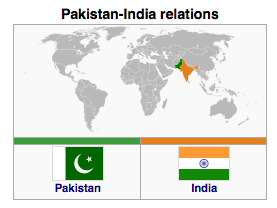Why Nuclear CBMs Don’t Work?: India And Pakistan Perspectives – Analysis
By IPCS
By Pradeepa Viswanathan
As repeated attempts at confidence building remain far from implementation, this article look into two specific questions. One, what are the major impediments to nuclear CBMs between India and Pakistan and second, how similar or different are the Indian and Pakistani perspectives over these impediments?
What are the impediments to nuclear CBMs?
India and Pakistan have had several CBMs comprising bilateral agreements, peaceful initiatives and dialogues at Foreign Minister, Secretary and Joint Secretary levels. Contrary to the fear of a nuclear flashpoint, they had long visualized the responsibility which the possession of nuclear weapon entails. Implementation of nuclear CBMs continues to be overpowered by four prime impediments.

The first and most often articulated impediment gains weight from the emotional dimension of Indo-Pak relationship. ‘Trust-deficit’ features in both misinterpretations and the irregularity of actual dialogue. India-Pakistan talks have been suspended several times in the last decade owing to the acts of violence unleashed by proxy actors, believed to be sponsored by Pakistan.
Second, the involvement of a third party, either as mediator or as conflict manager impinges on bilateral negotiations. South Asia has witnessed the recognized nuclear powers, the US and People’s Republic of China, make occasional appearances during periods of escalated tension. This has further led to lack of concretization of bilateral mechanisms.
Third, crucial elements of a successful CBM like communication – creation of hotlines, constraint – pre-notification of military exercises, transparency – data exchanges and verification – aerial or on-site inspections, also remain beyond true realization in the South Asian context.
Fourth, the media projection that each receives in the other’s country with usage of terms such as ‘arch rivals’, ‘sixty-four years of hostility’, ‘estranged neighbours’ depicts the negative representation in the symbolic expression of their relationship. On one hand, sections of the Indian media have preferred to link every terror attack, home-grown or otherwise, to Pakistan. On the other hand, Pakistani media and the vernacular press, highlight India’s hegemonic ambitions whereby its foreign policy is driven by enmity and sheer intolerance of its neighbour.
Understanding Indian and Pakistani perspectives
The impediment which has found resonance in both Indian and Pakistani perspectives has been the lack of trust between the two neighbours. No doubt, the essential premise of any CBM should be trust but their successful implementation is certainly not stalled by this factor alone. According to an Indian strategist Happymon Jacob, ‘states are functional and not emotional entities’ and as such the success of a CBM is dependent upon the structures and agreements of peace and cooperation reached upon by the parties. Another strand of similarity has been in context of institutionalization of bilateral mechanisms, both as binding agreements and as nuclear commissions (nuclear risk reduction centres). Pakistani perspectives on lack of institutionalization have been linked to the presence of a third actor. The two countries also unite over the need to continue with the dialogue process.
Indian and Pakistani perspectives have differed most evidently over the role of a third party for conflict mediation. While reports suggest that Pakistan has welcomed its ‘all weather friend’ – China to bridge the gap in Indo-Pak relations, Indian decision makers have stated their disapproval over the presence of a third party in bilateral negotiations as early as the Simla agreement of 1972. Differences have also cropped over the ‘constraint’ element of CBMs. There is confusion over pre-notification of ballistic missile tests and cruise missile tests, and whether the latter is covered by the 2005 agreement on the pre-notification of missile tests. Another difference of opinion among Indian decision-makers exists on whom to and whether to engage with in Pakistan; the army, the civilian government or the Taliban directly.
What next?
While the comparison undertaken brings to light the varied perspectives in India and Pakistan over the impediments to successful nuclear confidence building, the fact of these causal factors being viciously intertwined with one another complicates the situation. Moreover, some other questions also remain unanswered. If trust is a major impediment, then what explains the recurrence of these talks? Will both countries satiate themselves by restricting to just ‘talks about talks’? If one merely wishes CBMs to fulfil its basic function – that of reducing anxiety in a relationship and eventually making the behaviour of the other side predictable, then one can spend the next few decades waiting for the same. But if concrete measures are to be put in place with regards to clarity in nuclear behaviour and faithfully following existing agreements as well as defining new ones, then it is time to discount the emphasis on trust or the lack of it in our relationships. Institutionalization of bilateral mechanisms is the way ahead.
Pradeepa Viswanathan
Research Officer, IPCS
email: [email protected]
